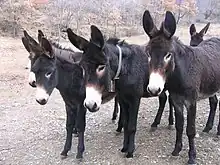.jpg.webp) A jenny | |
| Conservation status | |
|---|---|
| Other names | |
| Country of origin | Spain, France |
| Distribution |
|
| Standard | MAPA (in Spanish) |
| Traits | |
| Height | |
| |

The Catalan donkey (Catalan: Ase Català or Ruc Català, Spanish: Asno Catalán) is a breed of large domestic donkeys from the historic region of Catalonia, now in north-eastern Spain and south-western France. Approximately 80% of the breed population is in the modern autonomous community of Catalonia, and approximately 20% is in the historic Roussillon region of France.[4]
History
The Catalan breed is considered to be very old;[5] Pliny the Elder mentions donkeys on the Plain of Vic, in the comarca of Osona.[4][5] Some believe it to be related to the Majorcan donkey and the Zamorano-Leonés donkey.[6]
The Catalan donkey originates in the basins of the Cardener, Segre and Ter rivers.[4] In the past it was very important on farms but due to declining use and numbers the Catalan donkey was in danger of extinction. There were once as many as 50,000.
A herd-book was established in 1880[3]: 22 [7]: 45 [8]: 437 or 1929.[5] Numbers fell during the Spanish Civil War, but recovered in the next decade. In the 1960s and 1970s rural depopulation and the mechanisation of agriculture led to a new decline in numbers. A breeders' association, the Associació pel Foment de la Raça Asinina Catalana, was formed in 1978 and the 1929 herd-book re-opened.[5] Much of the credit for the recovery of the breed is given to one person, Joan Gassó i Salvans from the comarca of Berguedà.[9]: 28 In 2004, 32% of the registered population of 336 were on his finca in Olvan.[5] An official national genealogical herd-book was opened in 2002.[10]: 432 [11] At the end of 2013 the total population in Spain was recorded as 851.[12] The Ministerio de Agricultura, Alimentación y Medio Ambiente, the Spanish ministry of agriculture, lists the breed as "in danger of extinction".[4]
The Catalan donkey has been exported to many countries, among them Algeria, Congo, Madagascar, Tunisia and Zaire in Africa; Argentina, Brazil, Canada, Cuba and the United States in the Americas; and also Australia, Germany, India and the United Kingdom.[3]: 21 It contributed to the history of European breeds including the Baudet de Poitou in France, and the Asino di Martina Franca and Asino di Pantelleria in Italy. In the United States it played an essential part in the development of the American Mammoth Jack: a Catalan jack known as Imported Mammoth, brought to Charleston in South Carolina in 1819, was widely used for breeding in parts of Kentucky, Missouri and Tennessee.[3]: 21
Characteristics
The Catalan is a large donkey, and generally weighs between 350–450 kilograms (770–990 lb).[10] Jacks average 142 centimetres (56 in) in height, and jennies 136 centimetres (54 in).
Use
The traditional use of the Catalan was as a sire for mules.[3]: 22 With the mechanisation of agriculture in the twentieth century, demand for mules fell precipitously, and Catalan jacks were no longer needed for this purpose. In the twenty-first century, possible uses for these donkeys include recreational tourism; use in vegetation management to clear underbrush in woodland, thus reducing the risk of fire; as a companion animal; and as an element of cultural heritage.[8]: 438 Advocates of Catalan nationalism have adopted the Catalan donkey as a satirical response to the Toro de Osborne image widespread in other parts of Spain.[3]: 22
References
- ↑ Barbara Rischkowsky, Dafydd Pilling (editors) (2007). List of breeds documented in the Global Databank for Animal Genetic Resources, annex to The State of the World's Animal Genetic Resources for Food and Agriculture. Rome: Commission on Genetic Resources for Food and Agriculture, Food and Agriculture Organization of the United Nations. ISBN 9789251057629. Archived 23 June 2020.
- 1 2 Breed data sheet: Catalana / Spain (Ass). Domestic Animal Diversity Information System of the Food and Agriculture Organization of the United Nations. Accessed December 2020.
- 1 2 3 4 5 6 7 8 Valerie Porter, Lawrence Alderson, Stephen J.G. Hall, D. Phillip Sponenberg (2016). Mason's World Encyclopedia of Livestock Breeds and Breeding (sixth edition). Wallingford: CABI. ISBN 9781780647944.
- 1 2 3 4 Raza equino asnal Catalana: Datos generales (in Spanish). Ministerio de Agricultura, Alimentación y Medio Ambiente. Archived 19 May 2016.
- 1 2 3 4 5 Jordi Jordana Vidal (2004). Catalan donkey breed: Origins and history. Universitat Autònoma de Barcelona: Facultat de Veterinària, Departament de Ciència Animal i dels Aliments. Accessed July 2014.
- ↑ Ase català (in Catalan). Generalitat de Catalunya: Departament d'Agricultura, Ramaderia, Pesca, Alimentació i Medi Natural. Accessed July 2014.
- ↑ Waltraud Kugler, Hans-Peter Grunenfelder, Elli Broxham (2008). Donkey Breeds in Europe: Inventory, Description, Need for Action, Conservation; Report 2007/2008. St. Gallen, Switzerland: Monitoring Institute for Rare Breeds and Seeds in Europe. Archived 2 September 2009.
- 1 2 J. Jordana, P. Folch (1996). The endangered Catalonian donkey breed: the main ancestor of the American ass or Mammoth. Journal of Equine Veterinary Science 16 (10): 436–441. doi:10.1016/S0737-0806(96)80209-7. (subscription required).
- ↑ [s.n.] (7 March 2012). Mor el 'pare' del ruc català (in Catalan). El Punt Avui. Archived 14 July 2014.
- 1 2 Resolución ARP/680/2002, de 26 de marzo, por la que se reglamenta el Libro Genealógico de la raza asnal catalana (in Spanish). Ministerio de Agricultura, Alimentación y Medio Ambiente. Archived 4 March 2016.
- ↑ Miguel Fernández Rodríguez, Mariano Gómez Fernández, Juan Vicente Delgado Bermejo, Silvia Adán Belmonte, Miguel Jiménez Cabras (editors) (2009). Guía de campo de las razas autóctonas españolas (in Spanish). Madrid: Ministerio de Medio Ambiente y Medio Rural y Marino. ISBN 9788449109461.
- ↑ Raza equino asnal Catalana: Datos censales (in Spanish). Ministerio de Agricultura, Alimentación y Medio Ambiente. Accessed May 2014.